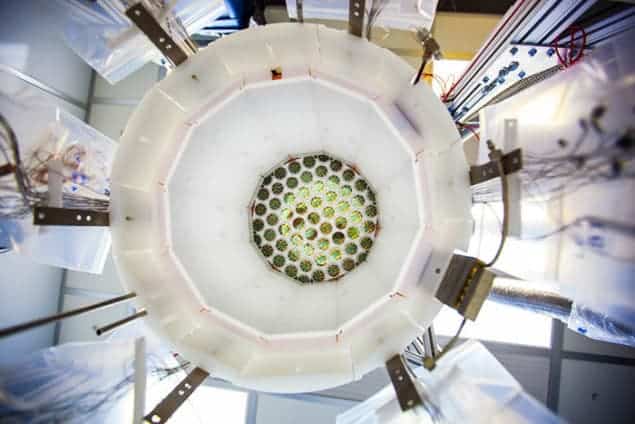
No evidence for dark matter has been seen in the final run of the Large Underground Xenon (LUX) dark-matter detector at the Sanford Underground Research Facility in the US. Despite running for 20 months at four times its original design sensitivity, it has seen no signs of the leading dark-matter candidate – weakly interacting massive particles (WIMPs).
“It would have been marvellous if the improved sensitivity had also delivered a clear dark-matter signal,” says Richard Gaitskell, co-spokesperson of LUX. “However, what we have observed is consistent with background alone.”
Dark matter is the name given to the mysterious substance thought to account for about 80% of matter in the universe. It does not appear to interact with light – hence its name – and has never been detected directly. Furthermore, dark matter is not described by the Standard Model of particle physics. Rather, its existence is inferred from astrophysical observations of processes such as galaxy formation and dynamics, which appear to be governed by gravitational forces exerted by dark matter.
Standard Model stand-off
This latest null result puts significant constraints on possible dark-matter candidates such as WIMPS. It also makes it less likely that dark matter will be detected at the Large Hadron Collider (LHC) at CERN. This feeds into fears that particle physicists may be facing the “nightmare scenario” in which the LHC and contemporary experiments such as LUX find no significant evidence of physics beyond the Standard Model.
Despite its elusive nature, the Milky Way is expected to be chock-full of dark matter, and the stuff should be streaming constantly through the Earth. Physicists have built several generations of increasingly sensitive detectors such as LUX to look for the tiny interactions that could occur between dark matter and normal matter. While most detectors have not seen any such interactions, others have reported tantalizing – and sometimes controversial – hints of dark-matter particles.
LUX is buried1500 m under the Black Hills in South Dakota, where the overbearing rock shields its sensitive detectors from cosmic rays and other background radiation. The detector is a 2 m-tall titanium tank filled with 350 kg of liquid xenon that is cooled to –108 °C.
Flashes of light
LUX is designed to detect WIMPs, which should collide occasionally with its xenon atoms. If this occurs, the recoiling atom will create light and some free electrons. The electrons are accelerated by an electric field, creating more light when they reach a thin layer of xenon gas at the top of the tank. Light signals at the collision point and the top of the tank are collected by extremely sensitive light detectors. The energy of the collision can be deduced from the brightness of the light. Requiring two signals from each event makes it easier to discriminate against light created by background radiation.
LUX was installed in 2012 and three months of data were analysed in 2013 – revealing no evidence of dark-matter collisions. Now, the LUX team has analysed data taken from October 2014 to May 2016 – the final run of the experiment. Half a million gigabytes of data have been processed using high-performance computing facilities at Brown University in Rhode Island and the Lawrence Berkeley National Laboratory in California.
Berkeley Lab’s Simon Fiorucci says, “The result is unambiguous data we can be proud of and a timely result in this very competitive field – even if it is not the positive detection we were all hoping for.”
WIMPs “alive and viable”
The LUX null result could help physicists to gain a better understanding of the nature of dark matter because it provides crucial information about what dark matter is not. This allows physicists to hone their dark-matter models by eliminating a large range of possible particle masses and interaction strengths with normal matter. While a null result might sound like bad news for the WIMP model, Gaitskell says that it “remains alive and viable”.
LUX physicists are now scouring their data for evidence of other hypothetical dark-matter particles such as axions and axion-like particles.
Now that LUX has shut down, many of its physicists have turned their attention to the experiment’s successor, the LUX-ZEPLIN experiment. To be built at Sanford, LUX-ZEPLIN will be based on 7000 kg of liquid xenon and is expected to be 70 times more sensitive than LUX when it starts taking data in 2020.
The results were presented yesterday at the Identification of Dark Matter 2016 conference in Sheffield, UK. A PDF of the presentation is available for download.



